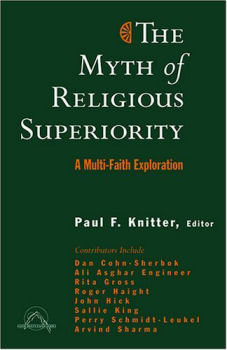
|
Posted February 14, 2006
Book: The Myth of Religious Superiority: A Multifaith Exploration Editor: Paul F. Knitter Orbis Books, Maryknoll, NY, 2006, pp.242 An Excerpt from the Introduction:
An Excerpt from the Book: The Next Step Beyond Dialogue Interfaith dialogue has been going on now on a growing scale and on many levels for more than a generation, and it must continue increasingly in the future. So to speak of the next step beyond dialogue is not intended to mean the end of dialogue and its replacement by something else. It is a way of enhancing dialogue, not replacing it. It is the step from dialogue between people who each believe, at the back of their minds and usually without saying it aloud, that theirs is really the one and only true or fully true faith, to dialogue between people who accept the genuine religious equality of the other, so that they can then benefit freely from one another’s distinctive spiritual insights and be free to join together in facing the massive social and economic and political problems of the world. So clearly this next step is not the different religions all becoming one, uniting to form some kind of new global religion. On the contrary, their plurality and diversity are positive and valuable. The variety around the world of our different ways of being human, which are the great cultures and religions of the earth, is something to celebrate and understand, not something to try to iron out. In exploring the next step I use the word salvation, acknowledging, of course, that it is not a universally used term but one most at home in Christian discourse. Salvation, then, is the aim of each of the great world religions. Each has a keen awareness of the reality of human suffering and of the human neglect, cruelty, injustice, exploitation, sheer ignorance, or thoughtlessness that cause most of it. They all recognize that there is something deeply and tragically defective in our ordinary human situation, both individually and collectively. They conceptualize this in various ways. Some express it by saying that we are fallen and therefore sinful beings; others that we are frail, fallible creatures, made out of the dust of the earth; others that all life is, in the Buddhist phrase, dukkha, defective, involving all manner of suffering; others again that we are living in blindness to the reality of our own deeper nature and of the larger reality of which we are part. These are all ways of pointing to the same observable facts. But in face of this dark side of life, which is all too evident, each of the great traditions nevertheless stands out as a form of what we can call cosmic optimism in that it proclaims the real possibility, which can even begin to be realized here and now of a limitlessly better state. And in each case, the movement toward the state consists in a progressive transformation from natural self-centeredness to a new orientation centered in the Ultimate Reality on which the religions are focused from their different angles. Table of Contents:Foundational Perspectives1. The next step beyond dialogue 2. Exclusivism, inclusivism, pluralism 3. Is the pluralist model a western imposition? Hindu and Sikh Perspectives 4. Mahatma Gandhi 5. Can there be more than one kind of pluralism? 6. Sikhism and religious pluralism Buddhist Perspectives 7. Excuse me, but what’s the question? 8. A pluralist view of religious pluralism Jewish Perspectives 9. Toward a pluralist theology of Judaism 10. Judaism and other faiths Christian Perspectives 11. The spirit and religious pluralism 12. Pluralist Christology as orthodox 13. Pluralism calls for pluralistic inclusivism 14. Power, politics, and plurality 15. The real and Trinitarian God Muslim Perspectives 16. Islam and pluralism 17. A Muslim pluralist: Jalaluddin Rumi |
|
